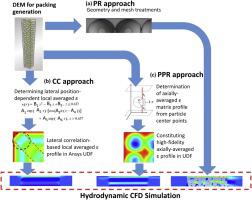Chemical Engineering and Processing: Process Intensification ( IF 4.3 ) Pub Date : 2020-03-13 , DOI: 10.1016/j.cep.2020.107905 Anthony Basuni Hamzah , Shinichi Ookawara , Shiro Yoshikawa , Hideyuki Matsumoto

|
Recently square-channel packed bed reactors with micro to milli dimensions are often found in the literature on process intensification. However, its porosity profiles and resultant flow behaviors have been overlooked. Therefore, this study proposes two new CFD approaches to model such reactors relying on the accurate local porosity profiles in the square bed. Discrete element method was employed to model random packed beds of monodisperse spherical particles in square channels with channel-to-particle size ratio of 3 to 10. The obtained lateral porosity profiles were axially averaged and expressed as a function of distance from the wall in three defined zones. Momentum source term to be added in the momentum conservation equation was calculated based on the local porosity profile functions in Correlations-based Continuum (CC) approach, while on the axially-averaged porosity profiles in Pseudo-Particle Resolved (PPR) approach. The square beds’ hydrodynamic behaviors were investigated using CC and PPR approaches, which were validated with Particle Resolved approach in terms of velocity profile, and with empirical correlations for pressure drop.
中文翻译:

狭窄方形通道填充床孔隙率分布与水动力的数值研究
最近,在有关工艺强化的文献中经常发现具有微米至毫米尺寸的方通道填充床反应器。然而,其孔隙率分布和所产生的流动行为已被忽略。因此,这项研究提出了两种新的CFD方法,以依靠在方形床中精确的局部孔隙率曲线来对这种反应器进行建模。采用离散元法对单分散球形颗粒在正方形通道中的随机堆积床进行建模,通道与颗粒的尺寸比为3到10。将获得的横向孔隙率轮廓轴向平均,并表示为距壁的距离的函数(三个)定义的区域。基于基于关联的连续体(CC)方法中的局部孔隙度分布函数,计算了要添加到动量守恒方程中的动量源项,而在采用伪颗粒分辨(PPR)方法的轴向平均孔隙率剖面上。使用CC和PPR方法研究了方形床的水动力行为,并通过粒子分解方法在速度分布方面以及压力降的经验相关性进行了验证。



























 京公网安备 11010802027423号
京公网安备 11010802027423号